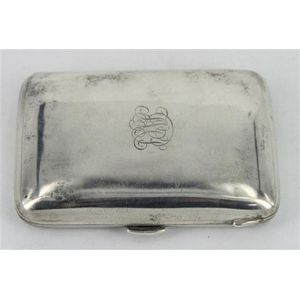Gold Sovereign Case and Celluloid Cigar Case
You must be a subscriber, and be logged in to view price and dealer details.
Subscribe Now to view actual auction price for this item
When you subscribe, you have the option of setting the currency in which to display prices to $Au, $US, $NZ or Stg.
- Carat - A carat (abbreviated "ct") is a unit of measurement used to describe the weight of a diamond or other gemstone, and separately is a unit of measurement used to describe the weight of precious metals such as gold,.
For gemstones, one carat is equal to 0.2 grams or 200 milligrams. The weight of a diamond is one of the Four Cs (along with cut, colour, and clarity) that are used to determine a diamond's value.
It is important to note that a diamond's weight does not necessarily correspond to its size. A diamond's cut, which affects how well it reflects light, can make a diamond of a lower weight appear larger than a diamond of a higher weight. Additionally, the carat is not the only factor to determine the value of a diamond, other factors such as clarity, colour and cut are important too.
In the gold industry, the purity of gold is measured in carats (abbreviated "ct"), with 24 karats being pure gold and lower carat numbers indicating a lower purity level. So, for example, 18 carat gold is 18/24 or 75% pure gold, and 12 carat gold is 12/24 or 50% pure gold. - Celluloid - In 1864 an American scientist by the name of Parkes mixed camphor with nitrocellulose, etc. The result was what came to be known as "celluloid", the first form of plastic, and a product for which Parkes could find no use.
Some time later when the supplies of ivory for making billiard balls were becoming difficult to obtain, an inventor produced a perfect billiard ball from a mould using "celluloid".
Toys, dolls and other products such as combs, cutlery handles and costume jewellery made from celluloid began appearing on the market from 1913 and continued to do so until the early 1950s by which time it was superseded by more modern products due to safety concerns because it was highly flammable and brittle product. - Circa - A Latin term meaning 'about', often used in the antique trade to give an approximate date for the piece, usually considered to be five years on either side of the circa year. Thus, circa 1900 means the piece was made about 1900, probably between 1895 and 1905. The expression is sometimes abbreviated to c.1900.
This item has been included into following indexes:
- smoking accessories, cigars
Visually similar items

Large sterling silver vesta hallmarked Birmingham 1912

A sterling silver cigarette case, plain form, initials engraved to lid of case; stamped Prouds. Weight 60.1g.

A large silver plated butler's tray, Boin Taburet, Paris, circa 1894 the rectangular tray having mask centred loop handles to either end, reeded edge, decorated with scrolling arabesques, inscribed 'NM' to centre, marked to verso 'BOIN TABURET A PARIS' 7 c

